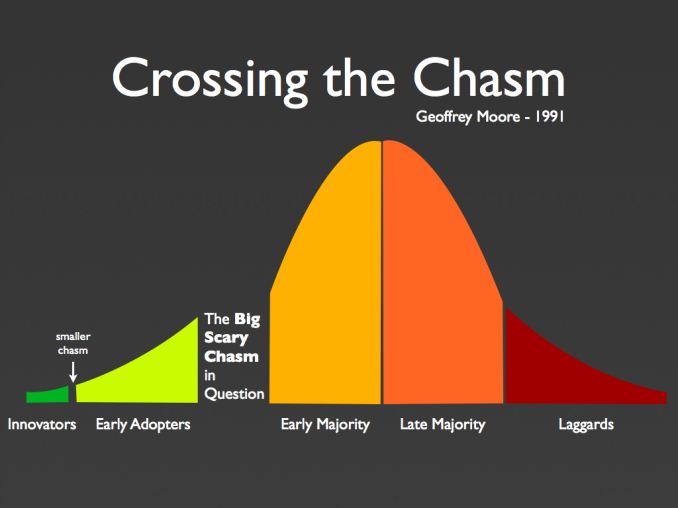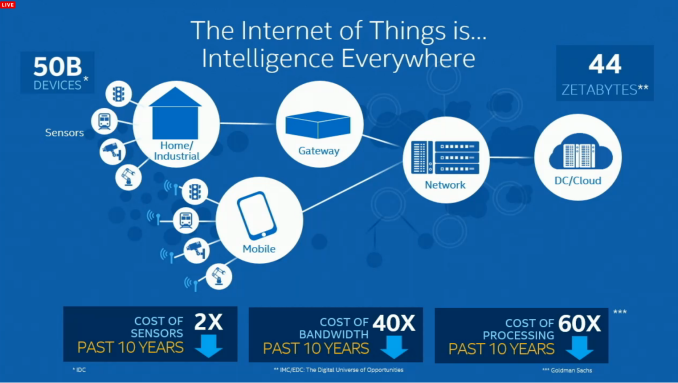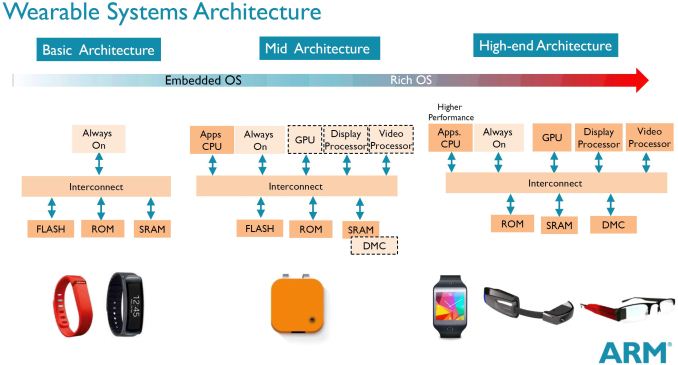Wearables: 2014 and Beyond
by Stephen Barrett on January 15, 2015 11:50 AM EST- Posted in
- Wearables
- Apple
- Microsoft
- pebble
- Android Wear
- Microsoft Band
- Fitbit

As the year 2014 has come to a close, now is a good time to inventory changes in the consumer electronics market and project those trends forward. One of the most obvious changes was that wearable technology has, by my observation, approached the brink of the adoption chasm into the early majority. In this article we will focus on the significant business and consumer factors of wearable technology, the notable introductions in 2014, as well as future AnandTech coverage.
If you are unfamiliar with ‘the chasm’, this is a reference to an acclaimed technology marketing book by Geoffrey A. Moore in 1991. As seen in the figure below, Geoffrey describes five stages of adoption.
The first, consumers described as innovators, are on the very bleeding edge. Innovators have a combination of unique interest in the subject area and abundant disposable income. There is a small chasm between this group and the next. This small chasm has killed many technologies and you could probably argue that 3D TVs died here. Next, early adopters are more like typical AnandTech readers. These consumers are technologically savvy and often the technology go-to person for groups of family and friends. Early adopters are likely to have made investments into products that their friends have yet to invest in themselves. My wife described me this way when I made the jump from iPhone to Windows Phone. It was an early product without majority adoption (and still is), but I wanted it anyway.
This brings us to The Big Scary Chasm in Question. How does a technology explode from a “hobby”, as famously Apple described its Apple TV, to a staple like the iPhone? In the information age of today, crossing this chasm is primarily a focus of marketing. Sure, you need good product, but without effective marketing there is little chance of wide adoption. There are plenty examples of products that have been favorably reviewed by AnandTech and others but didn't see widespread adoption. Often, it's a case of competing against the marketing budget of a much larger company, but that's a topic for another day. In short, going from a cult hit to a market leader is difficult; hence, the Chasm.
Taking this back to wearables, 2014 saw the most marketing of wearables yet, and for good reason. The traditionally explosive smartphone and tablet markets are slowing down. Analysts at CCS Insight projected a fall of smartphone sales' yearly growth from 40% in 2013 to 25% in 2014 and 15% in 2015. Analysts at Gartner project a fall of tablet sales' yearly growth from 55% in 2013 to 11% in 2014. IDC projects 2014 tablet growth even worse at 7%. At the same time, wearable revenue is projected to dramatically grow. ABI Research projects wearable technology at a compound annual growth rate (CAGR) of 56.1% over the next five years. Finally, Price Waterhouse Coopers’ interview samples show that 76% of consumers do not need a new wearable device to replace functionality of an existing device.
The top consumer eco system players – Apple, Microsoft, Google, and Google’s partners – are growth companies. Continually increasing revenue is a corporate foundation. Without revenue growth, careers stagnate as no promotions or raises are possible. Go long enough without growth and your top talent can leave for a company with growth opportunity. In Samsung’s recent 3rd Quarter financial results, their revenue fell 20% year over year and Samsung primarily attributed this to smartphone struggles.
With all this data combined, it is a no-brainer for these consumer companies to shift resources to wearables. Therefore, all have made significant wearable announcements. Google’s partners and Microsoft have launched devices while Apple is alone in the laggard position of having nothing on the market (with Apple Watch coming this year).
Wearables: What Are They?
At their core, wearables are of course technological devices that you wear. In some sense, your smartphone is actually a wearable. Even though a smartphone usually does not directly contact your body, it is a wearable just as much as a smart purse or backpack is a wearable. However, as smartphones are already a category of their own, they are traditionally excluded even though the core technology is vastly similar. That core technology consists of sensors, wireless, storage and computing. Intel’s recent IoT (Internet of Things) platform launch contained a slide detailing the cost reduction of some of these components, which is an enabling factor of wearable growth.
Where wearables differ from smartphones is their function. By breaking from the traditional smartphone form factor a wearable can provide different benefits. These benefits can be broken down into different categories that closely mirror the contents of the device as different sensors, processors, wireless, and storage enable different use cases.
On the left side of the above diagram from ARM are devices that contain wireless connectivity, sensors, a low power microcontroller such as Coretex-M, small amounts of memory and storage; run an embedded OS; and potentially have an optional display. The vast majority of these devices today are for fitness and health, however some provide smart watch functionality as well. On the middle and right side of the diagram are devices that integrate higher end processing and storage such as full-blown application processors (think Cortex-A series) and DDR memory. These allow running richer, non-embedded operating systems (such as Android) and higher-end features at the cost of power consumption.













79 Comments
View All Comments
codylee - Thursday, January 15, 2015 - link
I'm most excited about wearables moving past smartphones. I love the idea of Google Glass mixed with Erghis Sphere or Leap Motion style hand detection to interact rather than a brick like a smartphone. Then a watch style wearable may hold the compute power while the optics provide the GUI. I'd love to see these run on movement based energy though- or at the least body heat!codylee - Thursday, January 15, 2015 - link
Www.spaceglasses.com - completes the above lolDrumsticks - Thursday, January 15, 2015 - link
Nice article - i find it aligns with my own thoughts pretty well. I jumped onto the fitbit line with the Charge HR, and I think I'll pick up a moto 360 successor when it is out.Battery life obviously. I think the most important aspect of a wearable's display might be readability in light - you might be least likely to have your phone out when you're outside walking around. Watches also endure to some level more wear via hitting things i.e. Walls, desks, etc, so maybe some kind of scratchability test, if that doesn't violate any terms with the company or something.
Thanks for the article!
Baba G. Noush - Thursday, January 15, 2015 - link
Water resistant to 50m is not "incredible", it's just adequate. The two "real" watches I use are rated to 200m; I have routinely found that 50m-rated watches will not stand repeated dunks in a pool to no more than 2m. And as a use case, consider swimming, where I would like to count both strokes and laps, each of which should have a different signature on the accelerometer. There are devices that are useful for pacing (like a metronome for strokes) but they are all standalone and "dumb", they don't interface to anything.tipoo - Thursday, January 15, 2015 - link
I would have been interested in the Fitbit Surge, but man, did they miss the ball with the price point. It's the same price as the Moto 360 and more expensive than several other smartwatches, and "only" 100 dollars less than the base Apple Watch. At that price, it's just not feature competitive with them. It doesn't do enough yet, it's just like a Charge HR except with GPS and the ability to put in what you're doing right on the watch instead of on a seperate device later. I don't think that's worth the markup. But it certainly would be interesting at a lower price.Sxotty - Thursday, January 15, 2015 - link
I can say what I want. I want something to track runs, rides etc so I can leave phone at home. I want bumpers to protect screen and I would like to think about e-ink screen. I won't be watching movies on it. The microsoft band is close in many ways to what I want but the screen could be smaller and durability is an issue. Also I hear it cannot track rides.Anyway test durability, battery life, GPS, heart rate function then all the other junk.
Sxotty - Thursday, January 15, 2015 - link
I should also mention that I want control over my data. I don't want to pay a third party to download my data. I want the device to work with my device. Android, iPhone, or Windows phone.junky77 - Thursday, January 15, 2015 - link
I would like to have some emphasis on the extendability of the machine - maybe it's not specific to a specific model, but it's interesting. You'd like to know what's behind the borders of the wearable itselfZizy - Friday, January 16, 2015 - link
Out of all devices, I would love MS Band that is waterproof (not just splash resistant) and able to count laps in the pool. If it also survives 10m dives and measures depth, even better. Garmin has stuff I like (except too bulky), but not for the price I am willing to pay :)Samsung thingy that allows you to even make phone calls is also interesting, although I have a phone for that, I don't need another one on my wrist (yet; several versions later I might even buy it).
As for review, well battery life is obviously the big one. But most important part should be - why would you want that device? Focus on the purpose of the device and review from that perspective. Android wear devices all serve the same "phone companion" purpose, but not all other devices do, at least not to the same extent. And please, if you are a bunch of couch potatoes that will never be caught doing any other exercise than the naked one, don't review fitness devices :)
mkozakewich - Friday, January 16, 2015 - link
It might be time to finally create a standardized test for reflectance. Can you rig up a light box with a specific light output and a camera port at a certain distance and angle, so you can measure the contrast between white and black on the screen at 200 nits?The screen quality is actually desperately important. Half the reason people wear watches is for the delight of it. The screen on a wearable has to have that 'real' look or it just ruins the whole design.